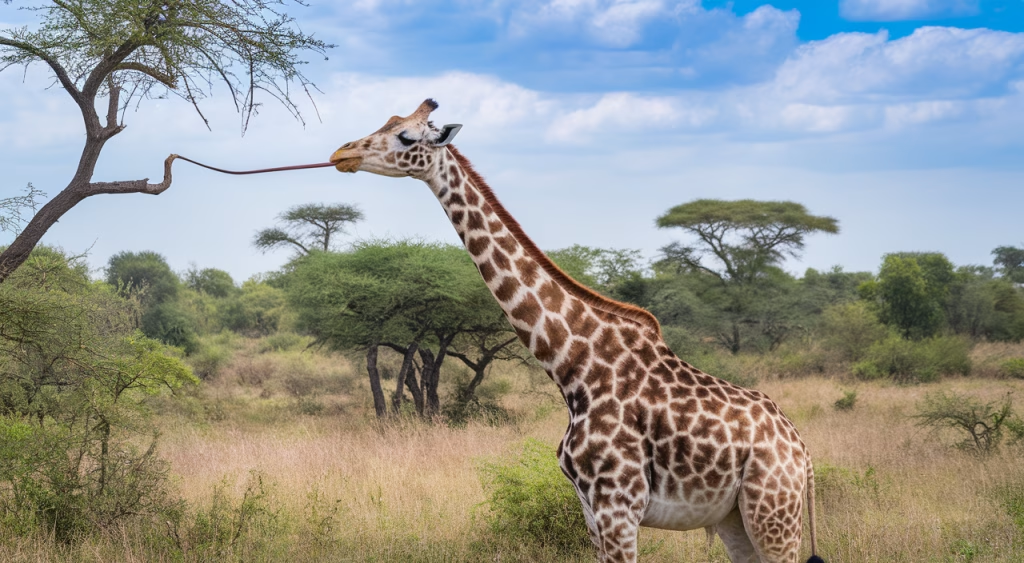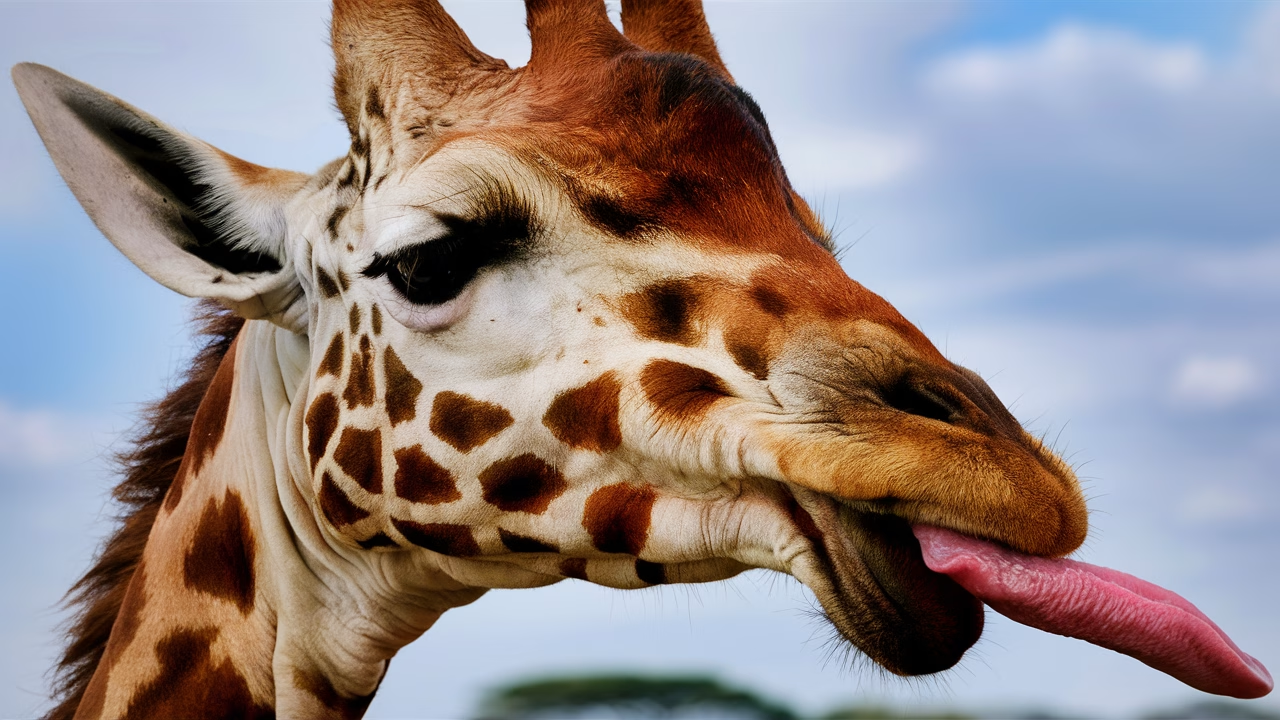How do giraffes clean their ears naturally?
Giraffes clean their ears using their incredibly agile and long tongues. With their tongues measuring up to 18–20 inches (45–50 cm) long, they can easily reach, explore, and remove debris from the inner crevices of their ears. This natural ear care in giraffes supports not only hygiene but also helps in parasite prevention—a vital aspect of giraffe survival in wild habitats.
TL;DR: Why Do Giraffes Clean Their Ears with Their Tongues?
- Built-In Hygiene Toolkit: Giraffes use their prehensile, muscular tongues—up to 20 inches long—to clean inside their ears.
- Anatomical Advantage: Their tongue’s flexibility and pointed tip allow precise movement into the ear canal.
- Health Benefits: Ear cleaning reduces parasites and debris that could cause infections.
- Evolutionary Smartness: With no hands, giraffes evolved this tongue trick for grooming hard-to-reach areas.
- More Than Ears: Giraffes also use their tongues to clean their noses, faces, and parts of their upper body.
Anatomy of a Giraffe’s Tongue
Nature’s Perfect Tool for Precision
Imagine trying to scratch your ear … but using only your tongue. For most of us, that would be laughably impossible. But giraffes? They’ve mastered the move. Their tongues are not only long—stretching around 18 to 20 inches—but also incredibly muscular and dexterous. Prehensile by design, a giraffe’s tongue wraps, grips, twists, and probes with surprising precision.
These long, dark blue tongues (the color protects them from sunburn!) are coated in thick saliva and toughened papillae. This adaptation allows giraffes to strip thorny acacia branches without injury—but it doubles as a cleaning tool for giraffe ear hygiene habits as well.
| Giraffe Tongue Feature | Function |
|---|---|
| Length (18–20 inches) | Reaches ears, muzzle, back |
| Prehensile Design | Wraps precisely around objects (or into ears!) |
| Dark Pigmentation | Protects from sun exposure |
| Thick Papillae | Provides texture and grip |
| High Saliva Production | Dislodges dirt and repels bacteria |
How Giraffes Use Their Tongue for Grooming
A Flexible Routine with Tongue Gymnastics
If you’ve ever watched a giraffe at a zoo or in the wild rhythmically licking itself, you witnessed giraffe tongue grooming behavior in action. These elegant herbivores use their horselike posture and remarkable neck range to twist around. Their tongue acts like a self-sanitizing washcloth capable of wet, strong, precise strokes.
Let’s break down their grooming technique:
- Step 1: Tongue Reach Test – A giraffe will often flick its tongue upward, curving backwards toward its ears.
- Step 2: Ear Canal Insertion – Using the narrow, pointed tip, it gently penetrates the ear canal, clearing out dust, dead skin, or parasites.
- Step 3: Post-cleaning Swipe – Often followed by a broad sweep down their face, neck, or chest.
Unlike other mammals that rely on mutual grooming or scratching limbs, giraffes have adapted this solitary cleanliness routine that demonstrates the benefits of giraffes cleaning ears with tongues. It’s solitary, it’s precise, and it works exceptionally well.
The Benefits of Giraffes Cleaning Their Ears
More Than a Quirky Habit—It’s Critical For Health
So what’s the big deal about giraffes cleaning their ears with their tongues? It turns out this behavior serves crucial purposes beyond tickling your curiosity.
- Parasite Prevention: In savanna environments, ticks and flies love nothing more than warm, dark ear canals. By cleaning inside their ears, giraffes remove these freeloaders before they cause infections or irritation.
- Temperature Regulation: Clean ears mean better airflow. Removing debris may indirectly help in dissipating body heat more efficiently.
- Communication Hygiene: Giraffes have acute hearing. Keeping their ear canals clean may improve auditory perception in vast landscapes where hearing distant cues is essential.
- Grooming Signals Social Status: In some observed cases, well-groomed giraffes tend to be healthier and potentially more desirable to mates. Cleanliness could be evolutionary currency.
Here’s what often happens—you’ll see a young male or female giraffe extensively cleaning its ears after rainfall or during fly season. That’s not vanity. It’s self-care rooted in survival instincts that showcase giraffe hygiene at its finest.
Other Unique Hygiene Habits of Giraffes
Going Beyond the Ears—Giraffe Body Care Strategies
Giraffes never cease to amaze us. Their giraffe grooming habits extend beyond the ears and into complex full-body maintenance:
- Nasal Cleaning: Giraffes also insert their tongue into their nostrils to clean dust, pollen, and mucus.
- Body Sweeping: With their neck flexibility, they can sweep their tongues across portions of their torso.
- Tail Swishes: Their tails act as natural fly swatters, keeping bugs off their hindquarters.
- Dust Bathing: In dry environments, giraffes may roll or shake dust across their body—a natural anti-parasite tactic.
Compare this with other animals: lions rely heavily on social grooming, elephants bathe in mud, and birds preen with their beaks. Giraffes, on the other hand, take the solo path—quiet, graceful, and tongue-first.
Conservation Implications of Giraffe Grooming Behaviors
Behavior That Binds Physiology and Survival
In the ever-growing conversation about wildlife health, observing simple behaviors like ear-cleaning can reveal deeper truths. Giraffe tongue grooming behavior is more than a hygiene quirk—it’s a bio-indicator of health.
In conservation zones or sanctuaries where giraffes display reduced self-grooming, it could signal distress, disease, or restricted mobility. A decrease in grooming often correlates with malnutrition, injury, or environmental stressors. Behavioral biologists actively monitor self-care habits as early warning signs.
Furthermore, understanding these habits informs how we design enclosures in zoos, rehabilitation centers, and protected reserves. Providing safe surfaces or natural stimulation—mimicking the grooming opportunities giraffes perform in the wild—leads to better welfare outcomes.
Final Thoughts: Tongues, Ears, and the Art of Giraffe Self-Care
When we think about body care in the animal kingdom, giraffes often don’t get the credit they deserve. But their clever use of that long, glistening tongue isn’t just fascinating—it’s vital. It’s a built-in, multifunctional tool evolved through millennia of natural innovation that demonstrates perfect natural ear care in giraffes.
So the next time you see a giraffe gently swirling its tongue into its ear, know that you’re witnessing nature’s quiet brilliance. It’s a reminder that survival often hinges not just on strength or speed—but on the beautifully bizarre ways species adapt to stay clean, healthy, and thriving.
Frequently Asked Questions
- Do all giraffes clean their ears with their tongues?
Yes, this is common behavior across both captive and wild giraffes, regardless of age or sex. - Is it harmful for giraffes to put their tongues in their ears?
No, their tongues are adapted for grooming and don’t damage their ear tissues. - Why don’t other animals clean their ears like this?
Most animals lack the tongue length, control, and flexibility that giraffes possess—so this isn’t a common trait. - Can a giraffe reach any part of its body with its tongue?
Not entirely. They can reach their ears, nose, and front torso—but not their full body. - How is this behavior beneficial to giraffe health?
It reduces parasites, enhances sensory accuracy, and contributes to overall physical well-being. - Is this behavior seen in young giraffes?
Yes, but young calves may take time to master the dexterity required. Mothers also assist with some grooming early on. - Do giraffes groom each other?
Unlike primates, giraffes rarely engage in social grooming. Most hygiene behaviors are self-directed.





